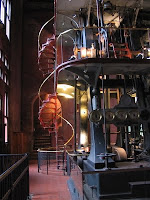Mercarto del Mare (aka The North End Fish Market) is located at 99 Salem Street in the North End. Owners Liz Ventura and Keri Cassidy followed their food dreams and left the corporate world to open the North End's only fish market. Mercato del Mare has been open now for nearly 3 years, so if you live in the North End and haven't been, be sure to get going.
Liz conducted the afternoon's lesson beginning with a description of the oysters of the day (Summer Side - PEI, Kumamoto - Washington State, and Blue Point - Connecticut). After we put on our gloves and learned about an oyster knife (a dull knife with a curved tip), the lesson began. Liz's easy to follow instructions had us shucking and eating in no time. Once we learned the steps, the only question left on our minds was what oyster to open and eat next.
My tips:
- Arrive early. 30-minute lessons are held every Saturday from 1 to 3pm, every hour and half hour. Given the market's small size, it's best to arrive early and claim a spot.
- Dress appropriately. Oyster shucking is not particularly messy but you may get a little splatter on your clothing.
- Pay for what you eat. The lessons are free, but the oysters themselves cost $1.75 to $2 each. Eat as many as you can shuck.
- Buy food at the market. The store also serves ready to eat items. The sushi looked delicious.





